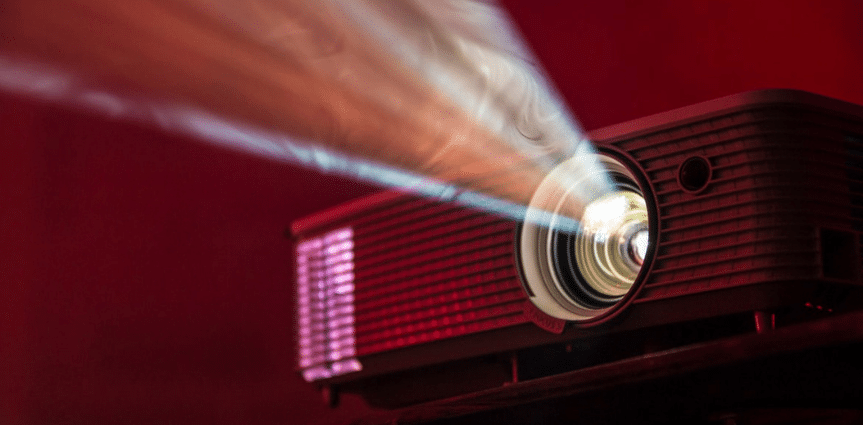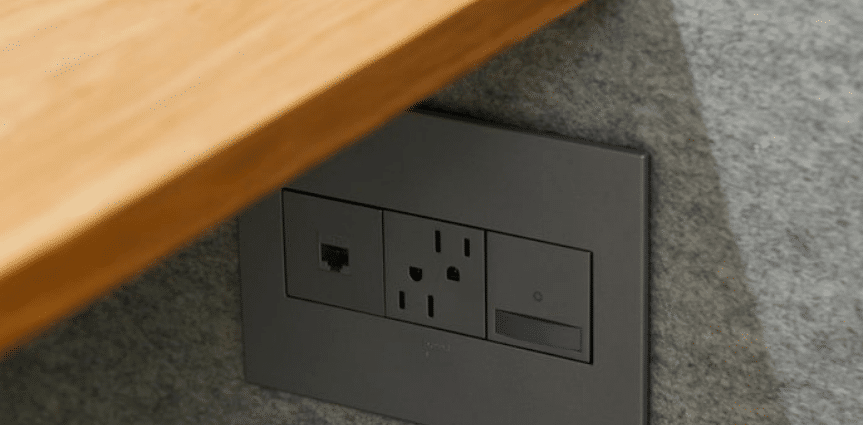So you’ve seen the initials LT, ST, or UST at the end of a projector model name and thought, “Ugh, yet another thing to consider.”
Do not fear!
In this article, we’ll be discussing the key differences between ultra short throw (UST), short-throw (ST), and long-throw (LT) projectors, which one is best for you, as well as a few other things to consider when shopping for your ideal projector.
Say goodbye to confusing abbreviations and meaningless numbers. This article will have you on your way to immersive home movies and clear conference presentations in no time.
Key Differences
Long throw projectors | Short throw projectors | Ultra short throw projectors |
Over 6ft from projector screen | 4-6ft from projector screen | Less than 2ft from projector screen |
Typically produces less heat | Typically produces excess heat | Usually includes a noisy fan for cooling |
More budget-friendly | More expensive | Most expensive |
Reliable image despite projector angle or support surface texture | Sensitive to surface angle and texture | Needs to be placed on low surface and very sensitive to surroundings |
Typically requires frequent bulb replacements | Has a longer light source lifetime | Has a longer light source lifetime |
Can be used on most white surfaces | Performs decently on most white surfaces | Requires specialized projection screen |
What exactly is “throw”?
When shopping for projectors, throw refers to the distance your projecting device will have to be from the projector screen to produce an image of your desired size and resolution.
A projector’s throw is the result of the type of lens that is used and can thus heavily impact factors such as image quality, brightness, size and product price.
Long throw projectors

These projectors need to be 6 or more feet from the projector screen to produce a high-quality image of desired size.
It is, however, suggested to have more than 6 feet available, as the projected image size can be increased by increasing the distance between the long throw projector and projector screen.
Long throw projectors tend to be a more budget-friendly option, as they generally have a less complex inner system than short throw projectors and require a lot less processing to produce image projections.
These projectors offer a lot of surface leniency, meaning that a stable projection can be acquired even when the projector is placed on uneven or textured surfaces.
Short throw projectors

Short throw projectors typically need to be 4 to 6 feet from the projector screen and can produce an impressive 100 plus inch image at that distance. This means that sizable projections can be acquired with very limited space.
This impressive feat does, however, come at the cost of excess heat generation, as short throw projectors make use of extensive image processing to produce large projections with little throw distance.
Short throw projectors are a lot more sensitive to the angle and surface they are kept on, meaning that a smooth, straight surface is required to prevent image distortion.
Ultra short throw projectors

Ultra short throw projectors take things a step further by creating large, detailed projections from only a few inches away from a projector screen. Typically, any projector that is meant to be placed closer than 2 feet from your projection surface is considered an ultra short throw projector.
Ultra short throw projectors require more focus on your projection surface than other types of projectors, as a plain white wall likely won’t produce the kind of quality image you’re hoping for. Instead, you may want to invest in a light reflecting screen specifically designed for this type of projector.
In spite of tricky drawbacks such as extreme environment sensitivity, noisy fan levels and limited projection size options, short throw projectors certainly predict exciting things for the future of projected entertainment.
Which Projector is best for you?
So how do all these things apply to your specific use case? The categories below are the key things to evaluate when deciding on whether a short throw or long throw projector is right for you.
Space

Ultra short throw projectors are ideal for small home theatres, while short throw projectors work well in class rooms or offices with limited space. This is because they don’t require massive conference halls to produce sizable, high-quality pictures.
They also allow for more walking space, as only the screen area needs to be avoided to prevent tripping over cables or causing damage to the projector.
On the other hand, long throw projectors have proven highly effective in larger spaces like lecture halls or conference rooms and are often suspended from the ceiling to prevent injuries or equipment damage.
If you have a larger space available, long throw projectors offer more projection size options, as the distance from the screen can be adjusted until the preferred image size is met.
Environment

If you are partial to a romantic outdoor movie night or would like to project content at an outdoor event, a long throw projector is the right choice for you.
This is due to the comparatively low sensitivity of long throw projectors to the surfaces they are on. You can count on a steady image, even if your supporting surface is less than perfect. Outdoor environments also tend to provide ample space to create projections of good quality and size with long throw projectors.
Outlet location

If you don’t have a lot of power outlet flexibility, a long throw projector might be more suitable to your environment.
his is due to the large throw distance range at which a long throw projector is able to produce a reliable image, meaning that you won’t need to struggle with extension cords, even if your outlet is far away from your screen.
Short throw and ultra short throw projectors are more limiting in this regard, as they have a very limited range in which they perform optimally.
Budget

If you are looking to create a simple home theatre without breaking the bank, you would likely appreciate the starting prices of long throw projectors.
While a projector is always going to be a pricey investment, you can expect quality short throw and ultra short throw projectors to leave AT LEAST a $1000 dent in your wallet, whereas long throw projectors start at a couple hundred bucks.
Regardless, we would highly suggest considering all aspects of your use case before deciding on a projector, as even the cheapest projectors are a waste of money if they don’t meet your projector requirements.
Other things to consider
Brightness
Lumen measurements are used to portray the brightness of a projector, with more lumens translating to a brighter projection.
This is very important, as it determines how dark the environment will have to be for the projector to produce a vibrant and clear image.
Typically, it is suggested to look for a projector with at least 2500 lumens to ensure your device is forgiving in less than ideal environments.
While not always the case, you are more likely to perceive better image brightness with projectors with shorter throw, as the closer the projector is, the brighter the projection will appear.
As ultra short throw projectors make use of laser light for projections, they tend to have a minimum brightness of 2000 lumens, with some even reaching up to 5000 lumens.
This differs from short throw projectors that mainly make use of LEDs, as reaching even 4000 lumens is a rare feat for these projectors.
Most long throw projectors are in the 3000 to 4000 lumens range, but outliers will produce a whopping 7500 lumens.
While this extreme brightness is tempting, bigger is not always better. It is suggested to only get a projector in that range of lumens if you plan to use it outdoors or in very big rooms with considerable light exposure.
Lifespan
The lifespan of a projector is dependent on the light source it uses for projection.
Projectors that make use of metal halide lamps will only offer around 5000 hours of viewing time, while LED or laser light sources offer tens of thousands of hours of entertainment.
Bear in mind that the projector itself will not need to be replaced in these increments, but rather the light source it utilizes.
While most projectors still make use of metal halide lamps, the tides are changing and their days are limited. Currently, you are more likely to find alternative lighting methods like LEDs in short throw projectors, while lasers are nearly exclusively used in ultra-short throw projectors.
LCD or DLP
LCD vs DLP is a difficult choice in the projector buying process, so we’ve decided to list the key features of each to help you decide in no time.
LCD projector
- More budget-friendly
- Uses less power
- Offers excellent brightness
- Harder to maintain
- Quiet operation
- Bulkier technology
DLP projector
- More expensive
- Offers exceptional resolution and sharpness
- Better color contrast
- Easier upkeep
- More portable
DLP technology is more likely to be found in short throw and ultra short throw projectors, which adds to their portability and makes it possible for them to utilize LED lights.
You can expect to find LCD technology in long throw projectors, which is why traditional lamps and bulkier designs can commonly be found in this category.
Resolution
A higher resolution results in a clearer, sharper image.
Resolution is measured in pixels and the lowest recommended resolution will be around 1920×1080, as that is the pixel requirement to run HD content.
You may find projectors across every throw category that offers the same resolution on the box, but long throw projectors will typically produce an image that appears sharper to the human eye.
Color output
This is often dependent on preference, as people have different color perception, but generally you want to look out for a good color contrast and natural-looking colors that are pleasing to your eye.
Short throw projectors tend to produce more color contrast but offer less saturation, while long throw projectors produce the opposite results.
Conclusion
The classification of a projector as either ultra short throw, short throw or long throw is dependent on the distance from the projector screen at which the projector performs optimally, with short throw and ultra short throw referring to projectors closer to the screen and long throw referring to projectors that perform better from further away.
Both of these projector types have their advantages and disadvantages but, ultimately, their value to you depends on your particular use case and viewing environment.
We hope the article above has helped to streamline your projector purchasing experience.
Photo Credit: Unsplash


